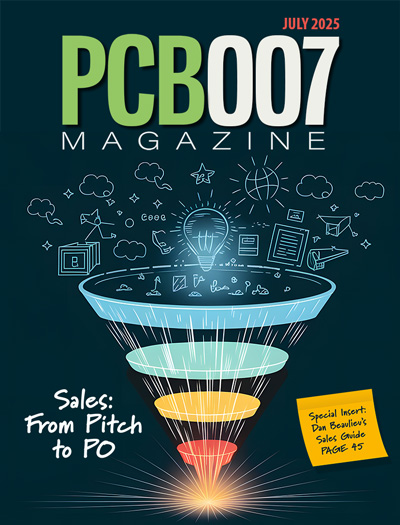-

- News
- Books
Featured Books
- pcb007 Magazine
Latest Issues
Current Issue
Advancing the Advanced Materials Discussion
Moore’s Law is no more, and the advanced material solutions to grapple with this reality are surprising, stunning, and perhaps a bit daunting. Buckle up for a dive into advanced materials and a glimpse into the next chapters of electronics manufacturing.

Inventing the Future With SEL
Two years after launching its state-of-the-art PCB facility, SEL shares lessons in vision, execution, and innovation, plus insights from industry icons and technology leaders shaping the future of PCB fabrication.

Sales: From Pitch to PO
From the first cold call to finally receiving that first purchase order, the July PCB007 Magazine breaks down some critical parts of the sales stack. To up your sales game, read on!
- Articles
- Columns
- Links
- Media kit
||| MENU - pcb007 Magazine
Estimated reading time: 1 minute
Flex Talk: Troubleshooting Flex Circuit Applications for Mil/Aero Projects
I imagine that everyone has been in this position at one time or another: Despite everyone’s best attempt at creating the perfect design, PCB fabrication and assembly, something goes wrong and the troubleshooting begins.
I had the opportunity to sit down with Ed Knutson, the president and founder of Dimation, to swap some of our best war stories. Ed specializes in quick-turn assembly and design. Our banter, to which I brought the fabrication piece of the puzzle, was primarily focused on flexible circuit applications for mil/aero projects. I am not sure if that is because of the more stringent requirements for those applications or because we both work regularly in that industry segment. At the end of our discussion, we concluded that most of our war stories could be traced back to a breakdown in communication and often simply not fully understanding how each piece of the design-fabrication-assembly puzzle fits together. Here are a few of our stories and lessons learned.
UL Materials
Aircraft applications typically require materials rated to UL94V-0. The assembly is complete and the burn test fails. What happened? The perfect storm. When the design files were created for fabrication and assembly, the UL requirements were noted in the assembly files only and called out by test requirements, not UL 94V-0. This was an ITAR application, so the PCB fab files were separated from the assembly files and forwarded to the flex manufacturer. Because there were no UL requirements listed on the fabrication notes, the supplier defaulted to their standard materials and the flex was not built with flame-retardant materials. That ex plains why the final assembly failed the burn test. Lesson Learned: Always clearly communicate UL requirements and include the requirement in both the PCB fabrication notes and the assembly notes.
To read this entire article, which appeared in the September 2016 issue of The PCB Magazine, click here.
More Columns from PCB Talk
PCB Talk: Is DWM Just Another Buzzword?PCB Talk: Burning Questions About Designing for SAP
PCB Talk: SAP—Changing the Way You Look at PCB Design
PCB Talk: SAP Evaluating From Design Perspective
PCB Talk: Creative Minds Pushing Boundaries
PCB Talk: Additive Electronics—Are You One of the Curious?
PCB Talk: Collaboration To Shorten the Learning Curve
PCB Talk: A Review of Additive Electronics


